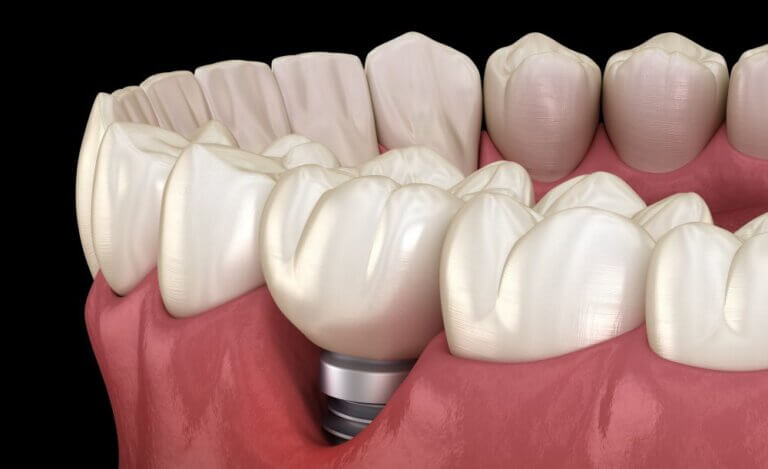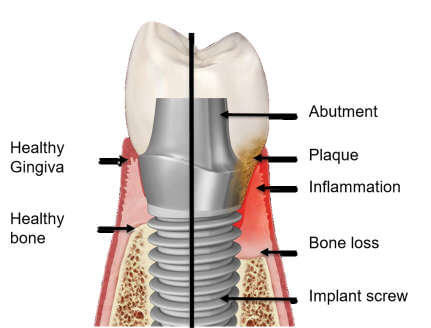What Is Peri-Implantitis?

What Is Peri-Implantitis?
Dental implants have become a popular and effective solution for replacing missing teeth. However, like any other dental treatment, there are risks and complications associated with dental implants. One of the most common complications is Peri-Implantitis.
Peri-Implantitis is a type of gum disease that affects dental implants. It is caused by the buildup of bacteria and plaque around the implant site, which leads to inflammation and infection of the surrounding gum tissue. If left untreated, Peri-Implantitis can cause pain and discomfort, bone loss, and even implant failure.
Before you contact a Toronto dentist to examine possible Peri-Implantitis, there are some things you should know as a patient:
- Why Do I Have Peri-Implantitis?
- Signs And Symptoms Of Peri-Implantitis
- Treatment Options For Peri-Implantitis
- How To Prevent Peri-Implantitis?
- Managing Peri-Implantitis Until You Can See The Dentist
If you have questions about Peri-Implantitis or other dental problems, please contact us for more information
Why Do I Have Peri-Implantitis?
Peri-Implantitis can develop due to several reasons. Here are some common causes:
- Poor Oral Hygiene: Just like with natural teeth, inadequate brushing, flossing and water-flossing around the implant site can lead to the buildup of plaque and bacteria, which can trigger Peri-Implantitis.
- Smoking: Smoking not only increases the risk of developing gum disease, but it also impairs the body’s ability to fight off infection, which can worsen the condition.
- Medical Conditions: Certain medical conditions, such as diabetes, a compromised immune response, and osteoporosis, can increase the risk of developing Peri-Implantitis by compromising the body’s ability to fight infection and heal.
- Improper Implant Placement: Improper placement of the dental implant or poor-quality implants can also increase the risk of Peri-Implantitis.
- Poorly fitting dental work: If a dental implant crown, dental implant bridge, or other restoration is not properly fitted, it can create spaces where bacteria can accumulate and cause infection.
- Genetic Predisposition: Someone who has a genetic predisposition to developing gum disease, or has had a history of gum disease, may be at increased risk of Peri-Implantitis.
It’s essential to identify the underlying cause of Peri-Implantitis to determine the appropriate treatment and prevent it from recurring. If you have further questions about Peri-Implantitis, please contact us.
Signs And Symptoms Of Peri-Implantitis
Peri-Implantitis symptoms can vary depending on the severity of the condition. Here are some signs and symptoms to look out for:
- Bleeding Gums: Bleeding around the implant site during brushing or flossing is a common symptom of Peri-Implantitis.
- Gum Swelling and Inflammation: Redness and swelling of the gums around the implant site are also signs of Peri-Implantitis.
- Pain or Discomfort: Peri-Implantitis can cause tenderness and discomfort in the gum tissues around the implant site.
- Loosening of Implant: As the condition worsens, the implant may become loose or unstable, which can affect biting and chewing.
- Pus or Discharge: In severe cases of Peri-Implantitis, there may be a dental abscess as well as yellow or green pus discharge from the gums around the implant site that can cause a foul taste.
If you experience any of these symptoms, it’s crucial to seek prompt treatment to prevent the condition from progressing further. If you have further questions about signs and symptoms of Peri-Implantitis, please contact us.

Treatment Options For Peri-Implantitis
Treating Peri-Implantitis involves addressing the underlying cause of the condition and preventing further damage to the implant and surrounding tissues. After examining the condition of the dental implant, your dentist may recommend one of several options:
- Professional Cleaning: A dental professional will perform a deep cleaning around the implant site to remove any plaque and bacteria buildup.
- Antibiotics: In some cases, antibiotics may be prescribed to help control the infection and reduce inflammation.
- Debridement Surgery: In advanced cases of Peri-Implantitis, surgery may be necessary to remove the infected tissue and promote healing.
- Implant Removal: In severe cases where there is too much bone loss around the dental implant, the implant may need to be removed to prevent further damage to the surrounding bone and tissue. The dentist can place a bone graft in the area and attempt to place a new dental implant at a later time.
Prompt treatment can help prevent further damage and improve the overall success of the implant. If you have further questions about your treatment options for Peri-Implantitis, please contact us.
How To Prevent Peri-Implantitis?
Preventing Peri-Implantitis involves maintaining good oral hygiene practices and taking steps to reduce your risk factors. Here are some tips to help prevent the development of Peri-Implantitis:
- Practice Good Oral Hygiene: Brush your teeth at least twice a day, floss daily, and use an antiseptic mouthwash to reduce plaque and bacteria buildup. Another highly recommended tool is the Waterpik waterflosser, which uses a high pressure water jet to clear away any missed debris.
- Quit Smoking: Smoking increases the risk of gum disease, including Peri-Implantitis. Quitting smoking can help reduce your risk of developing the condition as well as improve overall health.
- Regular Dental Visits: Regular dental checkups and cleanings can help detect any early issues with your implant and provide prompt treatment.
- Manage Medical Conditions: Manage any medical conditions that may increase your risk of developing gum disease, such as diabetes and osteoporosis. Speak to your family physician.
- Choose A Skilled Implant Provider: Choose an experienced dental professional for your implant placement to ensure proper placement and reduce the risk of complications.
By following these preventive measures, you can significantly reduce your risk of developing Peri-Implantitis and maintain the health of your dental implants. If you have further questions about how to prevent Peri-Implantitis, please contact us.

Managing Peri-Implantitis Until You Can See The Dentist
If you experience symptoms of Peri-Implantitis before you can see a dental professional, there are steps you can take to manage the condition:
- Rinse with Salt Water or Mouthwash: Rinsing your mouth with mouthwash or warm salt water can help reduce inflammation and control infection.
- Use a Soft-Bristled Toothbrush: Use a soft-bristled toothbrush to gently clean around the implant site without causing further damage.
- Avoid Hard Foods: Eating hard, crunchy, or chewy foods can aggravate the site that has peri-implantitis and cause more pain. Stick to soft foods and liquids until you can see a dentist. Also avoid eating on the affected side.
- Take Over-The-Counter Pain Medication: Over-the-counter pain medication, such as Advil (ibuprofen) or Tylenol (acetaminophen), can help relieve Peri-implantitis pain and reduce inflammation. Follow the instructions on the label and do not exceed the recommended dose. Unless you have a health condition that prevents you from taking either ibuprofen or acetaminophen, the absolute maximum dose that I recommend patients take for the worst dental pain is 600 mg ibuprofen combined with 1000 mg acetaminophen every 4 to 6 hours.
- Avoid Smoking: If you smoke, avoid smoking until you can see a dental professional. Smoking can exacerbate gum disease and delay healing.
It’s important to remember that these measures are temporary solutions and should not replace proper treatment from a dental professional. Seek prompt treatment as soon as possible to prevent further damage and improve the success of your implant. If you have further questions about Peri-Implantitis, please contact us.

